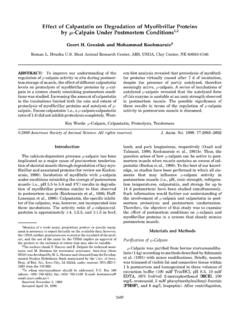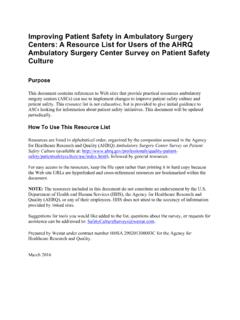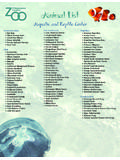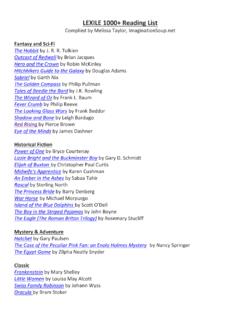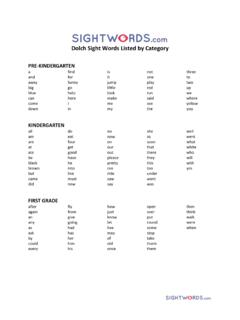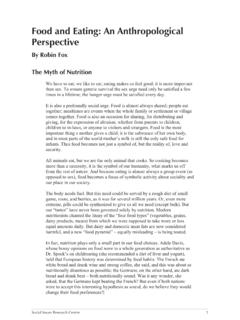Transcription of Nutritive V alue - USDA ARS
1 Nutritive Valueof FoodsUnited StatesDepartment ofAgricultureAgriculturalResearchService Home andGarden BulletinNumber 72iNutritive Valueof FoodsUnited StatesDepartment ofAgricultureAgriculturalResearchService Home andGarden BulletinNumber 72 Susan E. Gebhardt and robin G. Department of Agriculture, agricultural ResearchService, Nutrient Data Laboratory, Beltsville, MarylandiiAbstractGebhardt, Susan E., and robin G. Thomas. Value of Foods. Department ofAgriculture, agricultural research Service, Homeand Garden Bulletin 72 This publication gives in tabular form the nutritivevalues for household measures of commonly usedfoods. It was first published in 1960; the lastrevision was published in 1991. In this revision,values for total dietary fiber have been added andphosphorus values have been removed. Values arereported for water; calories; protein; total fat;saturated, monounsaturated, and polyunsaturatedfatty acids; cholesterol; carbohydrate; total dietaryfiber; calcium; iron; potassium; sodium; vitamin Ain IU and RE units; thiamin; riboflavin; niacin; andascorbic acid (vitamin C).
2 Data are from the of Agriculture Nutrient Database forStandard Reference, Release : ascorbic acid, calcium, calories,cholesterol, dietary fiber, fatty acids, foods, iron,niacin, nutrient composition, nutrient data,potassium, protein, riboflavin, salt, sodium, totalfat, vitamin AMention of trade names, commercial products, orcompanies in this publication is solely for thepurpose of providing specific information and doesnot imply recommendation or endorsement by Department of Agriculture over others sale by the Superintendent of Documents Government Printing Phone: toll free (866) 512-1800; DC area (202) 512-1800 Fax: (202) 512-2250 Mail: Stop SSOP, Washington, DC 20402-0001 The Department of Agriculture (USDA) prohibits discrimination in all its programs and activities on the basis ofrace, color, national origin, sex, religion, age, disability, political beliefs, sexual orientation, or marital or familystatus. (Not all prohibited bases apply to all programs.)
3 Persons with disabilities who require alternative means forcommunication of program information (Braille, large print, audiotape, etc.) should contact USDA s TARGET Centerat (202) 720-2600 (voice and TDD).To file a complaint of discrimination, write USDA, Office of Civil Rights, Room 326-W, Whitten Building, 1400 Independence Avenue, SW, Washington, 20250-9410 or call (202) 720-5964 (voice and TDD). USDA is anequal opportunity provider and employerRevised October by volume and for estimating amount of food of cooked meat per pound of raw meat as daily dietary sources of additional of total fat that provides 30 percent of calories andsaturated fat that provides 10 value of the edible part of and and and fruit , nuts, and and meat dishes and fast and poultry , sauces, and and and vegetable for table following people deserve special thanks fortheir roles in this project:Joanne M. Holden, research leader, Nutrient DataLaboratoryFood specialists of the Nutrient Data Laboratory,all of whom contributed data for the various foodgroups: Rena Cutrufelli, Vincent De Jesus, JacobExler, David Haytowitz, Gwen Holcomb, JulietteHowe, Linda Lemar, Pamela Pehrsson, andBethany ShowellDr.
4 Mark Kantor, associate professor and extensionspecialist, University of Maryland, College Park;Lisa Lachenmayr, extension educator, MarylandCooperative Extension Prince George s County;and Kristin Marcoe, nutritionist, USDA Center forNutrition Policy and Promotion, each of whomreviewed the manuscript and provided ozfluid ounceggramkcalkilocalorie (commonly known as calories)IUInternational Unitslbpound gmicrogrammgmilligrammlmilliliterNAnot availableozouncepkgpackageREretinol equivalentsqsquaretbsptablespoonTrtracet spteaspoon1 IntroductionAn 8-oz glass of milk, a 3-oz slice of cooked meat,an apple, a slice of bread. What food values doeseach contain? How much cooked meat will a poundof raw meat yield? How much protein should ahealthy 14-year-old boy get each day?Consumers want ready answers to questions likethese so they can plan nutritious diets forthemselves and their families. Also, nutritionists,dietitians, and other health professionals use thistype of information in their daily response, the Department of Agriculturepublished the first edition of this bulletin in nutrition researchers have revised it manytimes since to reflect our expanded knowledge, toadd or subtract specific values, and to update theever-growing list of available, commonly InformationThe USDA Nutrient Database for StandardReference is a more technical compilation ofnutrient information, with data for a much moreextensive list of foods and nutrients than thispublication provides.
5 It is revised regularly andpublished on the USDA Nutrient Data Laboratory(NDL) web site, < >. It replaces USDA s AgricultureHandbook 8, Composition of Foods..Raw,Processed, Prepared, commonly referred to as Handbook 8, and its revised sections, which areout of print. Special-interest tables such asIsoflavone Content of Foods are also publishedon the NDL web USDA Nutrient Database for StandardReference and special-interest tables produced byNDL are also available on CD-ROM from the Printing Office (GPO). See the backof the title page for contact nutrition publications that may be usefulinclude Nutrition and Your Health: DietaryGuidelines for Americans, USDA Home andGarden Bulletin 232; Making Healthy FoodChoices, USDA Home and Garden Bulletin 250;and Check It Out: The Food Label, the Pyramid,and You, USDA Home and Garden Bulletin publications may also be purchased fromGPO. See the back of the title page for Dietary Guidelines for Americans and the FoodGuide Pyramid can be found on USDA s Center forNutrition Policy and Promotion web site, < >, or write to them at 3101 Park Center Dr.
6 , Room 1064, Alexandria, VA22302-1594. Food label and other nutritioninformation can be found on the Food and DrugAdministration s Center for Food Safety andApplied Nutrition web site, < >, or write to them at200 C Street, SW, Washington, DC texts of the Recommended Dietary Allowancesand each volume of Dietary Reference Intakes areavailable from the National Academy Press, or 888-624-8373 (toll free).For more information about food and nutrition, visitthe USDA-ARS National agricultural Library sFood and Nutrition Information Center < >, or contact them at 10301 Baltimore Ave., Room 304, Beltsville, MD 20705-2351, Phone: 301-504-5719, Fax: 301-504-6409,TTY: 301-504-6856, e-mail: source of information on the Internet is< >.by Susan E. Gebhardt and robin G. Thomas, Department of Agriculture, agricultural research Service, Nutrient Data Laboratory, Beltsville, MarylandNutritive Value of Foods2 Literature CitedAmerican Institute for Cancer research . 2001. TheNew American Plate.
7 On the American Institute forCancer research web site < >, pageURL: < > (February 5,2002).Schuster, Ellen, compiler. 1997. Making Sense ofPortion Sizes. On the Oregon State UniversityExtension Family & Community Development website < >,page URL: < > (February 5, 2002).Standing Committee on the Scientific Evaluation ofDietary Reference Intakes, Food and NutritionBoard, Institute of Medicine. 1997. DietaryReference Intakes for Calcium, Phosphorus,Magnesium, Vitamin D, and Fluoride. NationalAcademy Press, Washington, 1998. Dietary Reference Intakes forThiamin, Riboflavin, Niacin, Vitamin B6, Folate,Vitamin B12, Pantothenic Acid, Biotin, andCholine. National Academy Press, Washington, 2000. Dietary Reference Intakes forVitamin C, Vitamin E, Selenium, and Academy Press, Washington, on the Tenth Edition of the RDAs,Food and Nutrition Board, Commission on LifeSciences, National research Council. Dietary Allowances, 10th Academy Press, Washington, Department of Agriculture, AgriculturalResearch Service.
8 2000. USDA Nutrient Databasefor Standard Reference, Release 13. The Service,Washington, Department of Agriculture and of Health and Human services . and Your Health: Dietary Guidelines forAmericans, 5th ed. USDA and DHHS, Home andGarden Bulletin Food and Drug Administration. 1999. FoodLabeling. Code of Federal Regulations, Title 21,part 101. [Available on the GovernmentPrinting Office web site < )>, 21 CFR101 URL: > (February 5, 2002)].3 Table 1. Equivalents by Volume and WeightThis table contains some helpful volume andweight equivalents. Following is an example thatillustrates how you can use the table:Example. For milk, the nutrient profile covers a1-cup serving (see page 20, table 9). Let s say youuse 2 tablespoons of milk in your coffee. In table 1,you see that 1 cup equals 16 tablespoons, so the2 tablespoons you consume are two-sixteenths orone-eighth of 1 cup. To find out the Nutritive valueof the amount you actually consume 2tablespoons you need to divide the nutrient valueslisted for milk by gallon ( liters; 3,786 ml)4 quarts1 quart ( liter; 946 ml)4 cups or 2 pints1 cup (237 ml)8 fluid ounces, Z\x pint, or16 tablespoons2 tablespoons (30 ml)1 fluid ounce1 tablespoon (15 ml)3 teaspoons1 pint2 cupsWeight1 pound (16 ounces) grams1 grams3Z\x ounces100 grams4 Table 2.
9 Tips for Estimating Amount ofFood ConsumedThis table lists some handy tips to help youestimate the amount of food you eat when youcannot measure or weigh and grainsZ\x cup cooked cereal, pasta, ricevolume of cupcake wrapper or half a baseball4-oz bagel (large)diameter of a compact disc (CD)medium piece of cornbreadmedium bar of soapFruits and vegetablesmedium apple, orange, peachtennis ballZ\v cup dried fruitgolf ball or scant handful for average adultZ\x cup fruit or vegetablehalf a baseball1 cup broccolilight bulbmedium potatocomputer mouse1 cup raw leafy greensbaseball or fist of average adultZ\x cup6 asparagus spears, 7 or 8 baby carrots orcarrot sticks, or a medium ear of cornMeat, fish, and poultry, cooked1 ozabout 3 tbsp meat or poultry2 ozsmall chicken drumstick or thigh3 ozaverage deck of cards, palm of averageadult s hand, half of a whole, small chickenbreast, medium pork chopCheese1 oz hard cheeseaverage person s thumb, 2 dominoes, 4 diceOther2 tbsp peanut butterPing-Pong ballZ\c cup nutslevel handful for average adultZ\x cuphalf a baseball or base of computer mouse1 cuptennis ball or fist of average adultNote.
10 The serving size indicated in the Food Guide Pyramid and on food labels is astandardized unit of measure and may not represent the portion of food a person actuallyeats on one : Schuster (1997), American Institute of Cancer research (2001).5 Table 3. Yield of Cooked Meat per Pound ofRaw Meat as PurchasedFrom the time it is purchased to the time it is eaten,meat undergoes certain losses. These includeevaporation of moisture and loss of fat in thedrippings during cooking and removal of parts suchas bone, gristle, and fat before or after table shows, for several retail cuts, the yield ofcooked meat from 1 pound of raw meat. Yield isgiven as ounces of:Cooked meat with bone and fatCooked lean and fatCooked lean onlyTable 3. Yield of Cooked Meat per Pound of Raw Meat as PurchasedYield after cooking, less drippingsRetail cut and method of cookingParts weighed Weight (oz)Chops or steaks for broiling or fryingWith bone and relatively large amount fat,Lean, bone, and fat10-12such as pork or lamb chops; beef rib;Lean and fat7-10sirloin, or porterhouse steaksLean only5-7 Without bone and with very little fat, suchLean and fat12-13as round of beef or veal steaksLean only9-12 Ground meat for broiling or frying, such asPatties9-13beef, lamb, or pork pattiesRoast for oven cooking (no liquid added)With bone and relatively large amount ofLean, bone, and fat10-12fat, such as beef rib, loin, chuck; lambLean and fat8-10shoulder, leg.




